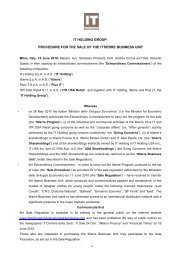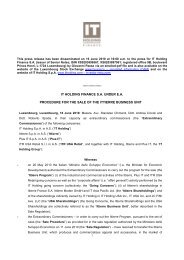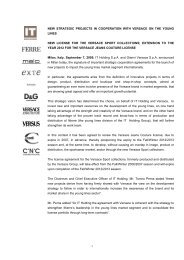Create successful ePaper yourself
Turn your PDF publications into a flip-book with our unique Google optimized e-Paper software.
a maximum of two years); (ii) a program of asset disposals (lasting a maximum of one year); (iii) moratorium<br />
on actions by creditors; (iv) appointment by the Government of a receiver (commissario straordinario) to<br />
substitute the existing management in the company’s operations.<br />
• Bankruptcy proceeding (fallimento). A request to declare a debtor bankrupt and to commence a bankruptcy<br />
proceeding (fallimento) for the liquidation of a debtor can be made by the debtor, a creditor, a court or a public<br />
prosecutor. The request must be approved by an insolvency court. Upon a declaration of bankruptcy: (i) subject<br />
to certain exceptions, all actions of creditors are stayed and creditors must file claims within a defined period;<br />
(ii) the administration of the debtor and the management of its assets pass from the debtor to the receiver; and<br />
(iii) any action taken by the debtor after a declaration of bankruptcy with respect to a creditor is ineffective.<br />
The bankruptcy proceeding is carried out and supervised by a court-appointed receiver, a deputy judge and a<br />
creditors’ committee. The receiver is not a representative of the creditors. The receiver is responsible for the<br />
liquidation of the assets of the debtor for the satisfaction of creditors. The proceeds from the liquidation are<br />
distributed in accordance with statutory priority. In Italy, liquidation proceedings can take a considerable<br />
amount of time, particularly in cases where the debtor’s assets include real property. As described below,<br />
Italian insolvency law provides for priority to the payment of certain preferential creditors, including<br />
employees and the Italian treasury.<br />
• Post-bankruptcy composition with creditors (concordato fallimentare). A bankruptcy (fallimento) can be<br />
terminated prior to the receiver’s liquidation by a debtor filing a petition to the insolvency court for a postbankruptcy<br />
composition with creditors (concordato fallimentare). In such a petition, the debtor must indicate:<br />
(i) the percentage of the unsecured claims that will be paid; (ii) the timing of the repayment; and (iii) the<br />
guarantees offered with respect to such repayment. The debtor must pay all debts of the secured creditors. The<br />
post-bankruptcy composition requires the approval of a majority, both in number and in amount of claims, of<br />
the debtor’s unsecured creditors and the court.<br />
In Italy, the highest priority claims (after the costs of the proceedings have been paid and other obligations<br />
undertaken by the receiver have been satisfied) include the claims of the Italian tax authorities and social security<br />
administrators and claims for employee wages. Secured creditors are repaid next with any remaining funds and<br />
payment of insecured creditors follows.<br />
As in other jurisdictions, there are so-called “claw-back” or avoidance provisions under Italian law that may give<br />
rise to the revocation of payments or the setting aside of grants of security interests made by the debtor prior to the<br />
declaration of bankruptcy. Claw-back rules under Italian law are normally considered to be particularly favorable<br />
to the trustee in bankruptcy in comparison to the rules applicable in the United States.<br />
In a bankruptcy proceeding (fallimento), Italian law provides for a claw-back period of up to two years. A<br />
bankruptcy receiver can request that certain transactions of the debtor during the two year-period preceding the<br />
declaration of bankruptcy be voided. In certain cases, the claw-back period can be extended to up to five years.<br />
A comprehensive reform of Italian bankruptcy laws is expected in the near future.<br />
Luxembourg<br />
Under Luxembourg insolvency laws, your ability to receive payment on the Notes may be more limited than it<br />
would be under U.S. bankruptcy laws. Under Luxembourg law, the following types of proceedings (collectively<br />
referred to as insolvency proceedings) may be opened against an entity such as the Issuer having its registered<br />
office or center of main interest in Luxembourg:<br />
• Bankruptcy proceedings (faillite), the opening of which may be requested by a company or by any of its<br />
creditors. Following such a request, the courts having jurisdiction may open bankruptcy proceedings if a<br />
company (i) stopped making payments as they became due (cessation des paiements) and (ii) has lost its<br />
commercial creditworthiness. If a court finds that these conditions are satisfied, it may also open bankruptcy<br />
proceedings, absent a request made by the company or a creditor. The main effect of such proceedings is the<br />
21






